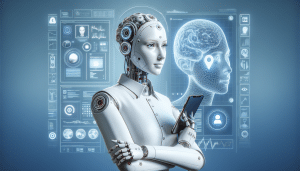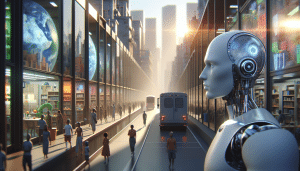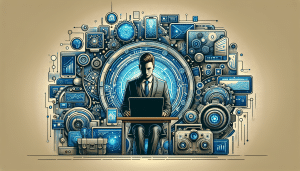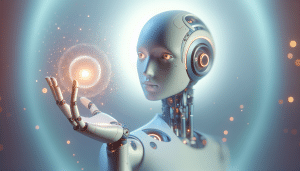The Everyday Impact of Artificial Intelligence
Oliver Cooper October 21, 2025
Uncover how artificial intelligence shapes everyday experiences in surprising ways. This comprehensive guide explores how AI is quietly transforming work, health, education, security, and entertainment—all while revealing what to watch for as technology advances.
Artificial Intelligence Powers Daily Interactions
Artificial intelligence is now deeply woven into routines—sometimes without notice. The technology is used in everything from unlocking phones with facial recognition to recommending what song to play next. AI handles massive volumes of data at lightning speed, powering apps and services that adapt instantly to preferences. This behind-the-scenes processing makes tasks feel almost effortless, as consumers interact with smarter search engines, translation tools, digital assistants, and more. Many tech industry leaders consider natural language processing and machine learning at the heart of innovation, enabling new products and personalizing content unlike ever before. The changes are subtle but widespread, redefining how individuals stay connected and informed. (Source: https://www.nist.gov/artificial-intelligence)
Intelligent recommendation systems have become a cornerstone of modern internet services. Streaming platforms and online stores analyze browsing and viewing patterns, then use prediction algorithms to suggest movies or products. By relying on artificial intelligence to anticipate tastes, companies provide each user with a tailored experience. These algorithms not only boost convenience but also expose users to new discoveries. Yet, despite the benefits, questions persist around data privacy and algorithmic bias. Understanding how AI influences choices is crucial for appreciating the opportunities and acknowledging the risks.
Voice technology stands as the most accessible form of AI in daily life. Virtual assistants are activated by a wake word and can perform complex tasks using speech recognition and natural language understanding. Setting reminders, checking the weather, or searching for information can now be done hands-free. Continuous improvements in machine learning enable these assistants to understand different accents and slang, making them more useful for diverse populations. As these technologies improve, dependency on AI for small but meaningful tasks is increasing, marking a key trend in technology’s everyday influence.
AI in Healthcare: Quiet Revolution in Medicine
The healthcare industry embraces artificial intelligence to streamline diagnostics and treatment recommendations. Medical imaging is one area where AI excels: systems can detect subtle anomalies in X-rays and MRI scans more quickly than ever, often supporting early detection of conditions like cancer. These advances mean that medical professionals are using AI as an extra set of eyes, potentially improving accuracy and speeding up care. Healthcare organizations are adopting AI to process patient records, predict disease outbreaks, and even automate administrative workflows for efficiency. This revolution is radical yet discrete, benefiting patients and doctors without always being visible. (Source: https://www.nih.gov/news-events/artificial-intelligence-healthcare)
Telehealth and remote care technologies, accelerated by global needs, often rely on sophisticated AI algorithms. These tools can analyze symptoms submitted through apps, triage cases, and recommend next steps or interventions. Some systems support chronic condition management, such as diabetes monitoring and heart rate tracking, using continuous data collection. AI enables real-time alerts to medical staff or caregivers when abnormalities arise. This growing digital health infrastructure expands access to services and bridges gaps for patients in remote or underserved areas.
AI also supports medical research by processing massive datasets at speeds impossible for humans. Tasks such as scanning genetic data or modeling drug interactions have become more efficient, helping accelerate breakthroughs. Clinical decision support systems use historical health information to guide choices and minimize errors. By learning continuously, these platforms can adapt as new research emerges, furthering evidence-based care. While challenges remain around transparency and ethics, the impact of artificial intelligence in healthcare is creating a more responsive and data-driven environment for all stakeholders.
Shaping the Future of Work With Smart Automation
Modern workplaces are undergoing transformation thanks to artificial intelligence-driven automation. AI optimizes scheduling, analyzes large volumes of business data, and automates time-consuming processes, freeing up employees for higher-value work. From chatbots handling customer inquiries to fraud detection in finance, smart software streamlines operations across industries. AI-powered analytics offer leaders new insights, allowing them to make data-driven decisions and respond more rapidly to market changes. This shift affects businesses of all sizes, igniting conversations about skills needed for future careers. (Source: https://www.brookings.edu/articles/ai-and-the-future-of-work)
The gig economy and flexible work arrangements gain traction with AI support. Platforms matching freelance or contract workers to projects rely heavily on algorithms for vetting, rating, and connecting talent. Smart tools can scan through resumes, assess qualifications, and suggest customized training to upskill workers for evolving job roles. By automating routine and repetitive work, AI also contributes to higher productivity, although it raises questions about job displacement and reskilling needs. Balancing automation’s benefits with workforce wellbeing remains a key area of study and policy debate.
Robotics and autonomous systems have entered logistics, warehouses, and manufacturing lines, improving accuracy and safety. Machines guided by AI vision can perform sorting, packaging, and even inspect products for defects in real time. In some offices, digital collaboration tools powered by machine learning streamline remote teamwork and project management. This integration of AI redefines what work looks like at every level, with a continued emphasis on blending human creativity and judgment with automation’s precision. The transition is complex and ongoing, but its influence is undeniable in shaping work environments now and in the future.
Education Gets a Personalized Update From AI
Education technology has experienced dramatic changes with the infusion of artificial intelligence. Adaptive learning platforms use real-time analytics to adjust lessons to each student’s needs and learning pace, creating a sense of personalized tutoring within group settings. These intelligent systems can highlight areas where learners struggle and suggest targeted exercises, making education feel more interactive. Institutions and teachers are using AI-based assessment tools to minimize grading workload, giving more room for instruction and creativity. Personalization powered by machine learning increases engagement and can help bridge achievement gaps. (Source: https://www.ed.gov/ai-in-education)
Virtual classrooms and e-learning platforms incorporate AI-driven chatbots and virtual assistants to answer questions on demand. Students receive timely support without waiting for instructor feedback, boosting independence. AI can help design customized study plans and recommend learning materials tailored to interests and skill levels. These systems make lifelong learning more accessible, helping individuals reskill or pursue new interests at any age. The technology does not replace teachers, but rather empowers both students and educators with better tools for discovery.
Concerns regarding AI in education include data privacy, equity, and the quality of recommendations generated by algorithms. Educators and developers are working to ensure that AI systems remain transparent and avoid reinforcing existing biases. By promoting digital literacy and focusing on ethical development, the education sector seeks to maximize AI’s benefits while protecting student wellbeing. The landscape continues to evolve as institutions adopt technology with care and attention to fairness, foreshadowing a future where every learner can thrive in artificial intelligence-augmented environments.
Smart Homes and Security Benefit From AI
Homes equipped with AI-powered devices are becoming common, and users are experiencing a new level of convenience and control. Smart thermostats, lighting, and appliances can learn routines over time, then automatically adjust for comfort and efficiency. These systems respond to voice commands or can be managed remotely via apps, bringing automation to daily life. AI security cameras and alarm systems detect unusual activity, helping improve both safety and peace of mind. The appeal of a smart home lies in subtle improvements that create a seamless, connected environment. (Source: https://www.energy.gov/energysaver/save-electricity-and-fuel/smart-home-technologies)
Video doorbells and surveillance equipment use machine learning to distinguish between people, animals, or vehicles, minimizing false alarms. AI algorithms allow these devices to flag anything out of the ordinary and send alerts if needed. Smart locks and integrated systems offer remote access and can grant temporary digital keys to trusted visitors. As smart home technology advances, there is an increasing emphasis on security protocols that protect sensitive user data from unauthorized access.
Energy management is another area where AI shines. Systems can track electricity usage, identify waste, and suggest optimizations to lower bills and carbon footprints. Some platforms integrate renewable energy sources and adjust power consumption dynamically. By analyzing habits and predicting needs, smart homes reduce environmental impact and make sustainable living more attainable. With greater connectivity and personalization, AI is making homes not just more convenient, but also responsible participants in broader ecological efforts.
AI Entertainment: Creativity Meets Technology
Artificial intelligence has quietly become a creative collaborator in entertainment. Music streaming services deploy advanced algorithms to curate playlists, matching moods and occasions with a level of customization that feels almost personal. Visual arts and design tools use AI to assist with photo editing, graphic production, and even generate artwork from scratch. Gamers encounter adaptive characters and environments that adjust to playing styles, creating more dynamic experiences. The synergy between art and technology shapes new consumption patterns and pushes creative boundaries. (Source: https://www.pewresearch.org/internet/2023/02/08/experts-ai-and-the-future-of-human-identity)
Film and video production also rely on AI for scene editing, script-predicting, and even voice dubbing. These innovations save time and can enhance storytelling with effects that were previously too costly or labor-intensive. Audience data allows studios to anticipate preferences and develop content for niche markets or underrepresented genres. By automating laborious tasks, creative minds focus on ideation and experimentation. AI is not replacing artists—it is instead amplifying their potential with intelligent tools that complement human imagination.
Live events, sports broadcasts, and news outlets turn to AI systems for real-time analytics and personalized highlights. Subtitles, translations, and accessibility features are generated almost instantly, making global communication and participation easier. The entertainment sector is expected to continue evolving as advanced technology opens up fresh forms of content and engagement. With transparency and intentional design, the partnership between AI and creativity will remain a source of fascination and possibility for years to come.
References
1. National Institute of Standards and Technology. (n.d.). Artificial Intelligence. Retrieved from https://www.nist.gov/artificial-intelligence
2. National Institutes of Health. (n.d.). Artificial Intelligence in Healthcare. Retrieved from https://www.nih.gov/news-events/artificial-intelligence-healthcare
3. Brookings Institution. (n.d.). AI and the future of work. Retrieved from https://www.brookings.edu/articles/ai-and-the-future-of-work
4. U.S. Department of Education. (n.d.). Artificial Intelligence in Education. Retrieved from https://www.ed.gov/ai-in-education
5. U.S. Department of Energy. (n.d.). Smart Home Technologies. Retrieved from https://www.energy.gov/energysaver/save-electricity-and-fuel/smart-home-technologies
6. Pew Research Center. (2023). Experts: AI and the future of human identity. Retrieved from https://www.pewresearch.org/internet/2023/02/08/experts-ai-and-the-future-of-human-identity







